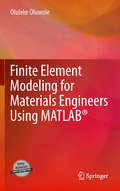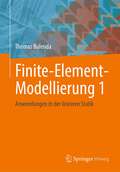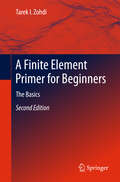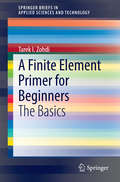- Table View
- List View
Finite Element Methods for Engineering Sciences: Theoretical Approach and Problem Solving Techniques
by Joel ChaskalovicThis self-tutorial offers a concise yet thorough grounding in the mathematics necessary for successfully applying FEMs to practical problems in science and engineering. The unique approach first summarizes and outlines the finite-element mathematics in general and then, in the second and major part, formulates problem examples that clearly demonstrate the techniques of functional analysis via numerous and diverse exercises. The solutions of the problems are given directly afterwards. Using this approach, the author motivates and encourages the reader to actively acquire the knowledge of finite-element methods instead of passively absorbing the material, as in most standard textbooks. The enlarged English-language edition, based on the original French, also contains a chapter on the approximation steps derived from the description of nature with differential equations and then applied to the specific model to be used. Furthermore, an introduction to tensor calculus using distribution theory offers further insight for readers with different mathematical backgrounds.
Finite Element Methods for Navier-Stokes Equations: Theory and Algorithms (Springer Series in Computational Mathematics #5)
by Vivette Girault Pierre-Arnaud RaviartThe material covered by this book has been taught by one of the authors in a post-graduate course on Numerical Analysis at the University Pierre et Marie Curie of Paris. It is an extended version of a previous text (cf. Girault & Raviart [32J) published in 1979 by Springer-Verlag in its series: Lecture Notes in Mathematics. In the last decade, many engineers and mathematicians have concentrated their efforts on the finite element solution of the Navier-Stokes equations for incompressible flows. The purpose of this book is to provide a fairly comprehen sive treatment of the most recent developments in that field. To stay within reasonable bounds, we have restricted ourselves to the case of stationary prob lems although the time-dependent problems are of fundamental importance. This topic is currently evolving rapidly and we feel that it deserves to be covered by another specialized monograph. We have tried, to the best of our ability, to present a fairly exhaustive treatment of the finite element methods for inner flows. On the other hand however, we have entirely left out the subject of exterior problems which involve radically different techniques, both from a theoretical and from a practical point of view. Also, we have neither discussed the implemen tation of the finite element methods presented by this book, nor given any explicit numerical result. This field is extensively covered by Peyret & Taylor [64J and Thomasset [82].
Finite Element Methods for Nonlinear Optical Waveguides
by Xin-Hua WangThis book provides researchers at the forefront of nonlinear optical technologies with robust procedures and software for the systematic investigation of the fundamental phenomena in nonlinear optical waveguide structures. A full vectorial electromagnetic formulation is adopted and the conditions under which simplification to a scalar formulation is possible are clearly indicated. The need to model the dielectric saturation properly is identified, and improved algorithms are presented for obtaining the complete power dispersion curve of structures exhibiting bistability. As the stability analysis of nonlinear modes is crucial to the development of nonlinear model methods, an effective procedure to investigate the propagation of the scalar nonlinear waves in 3D is another important feature of the book. All of the procedures described, as well as an automatic mesh generator for the finite element method, are incorporated into a software package which is included with this book.
Finite Element Methods for Nonlinear Optical Waveguides
by Xin-Hua WangThis book provides researchers at the forefront of nonlinear optical technologies with robust procedures and software for the systematic investigation of the fundamental phenomena in nonlinear optical waveguide structures. A full vectorial electromagnetic formulation is adopted and the conditions under which simplification to a scalar formulation is possible are clearly indicated. The need to model the dielectric saturation properly is identified, and improved algorithms are presented for obtaining the complete power dispersion curve of structures exhibiting bistability. As the stability analysis of nonlinear modes is crucial to the development of nonlinear model methods, an effective procedure to investigate the propagation of the scalar nonlinear waves in 3D is another important feature of the book. All of the procedures described, as well as an automatic mesh generator for the finite element method, are incorporated into a software package which is included with this book.
Finite Element Methods in Civil and Mechanical Engineering: A Mathematical Introduction
by Arzhang Angoshtari Ali Gerami MatinThe finite element method is widely employed for numerical simulations in engineering and science due to its accuracy and efficiency. This concise introduction to the mathematical theory of the finite element method presents a selection of applications in civil and mechanical engineering including beams, elastic membranes, the wave equation, heat transfer, seepage in embankment, soil consolidation, incompressible fluids, and linear elasticity. Jupyter notebooks containing all Python programs of each chapter can be downloaded from the book's companion website. Arzhang Angoshtari is an assistant professor and Ali Gerami Matin is a graduate student, both in the department of Civil and Environmental Engineering at the George Washington University, USA. Their research interests cover theoretical and computational mechanics and finite element methods.
Finite Element Methods in Civil and Mechanical Engineering: A Mathematical Introduction
by Arzhang Angoshtari Ali Gerami MatinThe finite element method is widely employed for numerical simulations in engineering and science due to its accuracy and efficiency. This concise introduction to the mathematical theory of the finite element method presents a selection of applications in civil and mechanical engineering including beams, elastic membranes, the wave equation, heat transfer, seepage in embankment, soil consolidation, incompressible fluids, and linear elasticity. Jupyter notebooks containing all Python programs of each chapter can be downloaded from the book's companion website. Arzhang Angoshtari is an assistant professor and Ali Gerami Matin is a graduate student, both in the department of Civil and Environmental Engineering at the George Washington University, USA. Their research interests cover theoretical and computational mechanics and finite element methods.
Finite Element Methods in Incompressible, Adiabatic, and Compressible Flows: From Fundamental Concepts to Applications (Mathematics for Industry #19)
by Mutsuto KawaharaThis book focuses on the finite element method in fluid flows. It is targeted at researchers, from those just starting out up to practitioners with some experience. Part I is devoted to the beginners who are already familiar with elementary calculus. Precise concepts of the finite element method remitted in the field of analysis of fluid flow are stated, starting with spring structures, which are most suitable to show the concepts of superposition/assembling. Pipeline system and potential flow sections show the linear problem. The advection–diffusion section presents the time-dependent problem; mixed interpolation is explained using creeping flows, and elementary computer programs by FORTRAN are included. Part II provides information on recent computational methods and their applications to practical problems. Theories of Streamline-Upwind/Petrov–Galerkin (SUPG) formulation, characteristic formulation, and Arbitrary Lagrangian–Eulerian (ALE) formulation and others are presented with practical results solved by those methods.
Finite Element Model Updating in Structural Dynamics (Solid Mechanics and Its Applications #38)
by Michael Friswell J.E. MottersheadFinite element model updating has emerged in the 1990s as a subject of immense importance to the design, construction and maintenance of mechanical systems and civil engineering structures. This book, the first on the subject, sets out to explain the principles of model updating, not only as a research text, but also as a guide for the practising engineer who wants to get acquainted with, or use, updating techniques. It covers all aspects of model preparation and data acquisition that are necessary for updating. The various methods for parameter selection, error localisation, sensitivity and parameter estimation are described in detail and illustrated with examples. The examples can be easily replicated and expanded in order to reinforce understanding. The book is aimed at researchers, postgraduate students and practising engineers.
Finite Element Model Updating Using Computational Intelligence Techniques: Applications to Structural Dynamics
by Tshilidzi MarwalaFEM updating allows FEMs to be tuned better to reflect measured data. It can be conducted using two different statistical frameworks: the maximum likelihood approach and Bayesian approaches. This book applies both strategies to the field of structural mechanics, using vibration data. Computational intelligence techniques including: multi-layer perceptron neural networks; particle swarm and GA-based optimization methods; simulated annealing; response surface methods; and expectation maximization algorithms, are proposed to facilitate the updating process. Based on these methods, the most appropriate updated FEM is selected, a problem that traditional FEM updating has not addressed. This is found to incorporate engineering judgment into finite elements through the formulations of prior distributions. Case studies, demonstrating the principles test the viability of the approaches, and. by critically analysing the state of the art in FEM updating, this book identifies new research directions.
Finite Element Modeling and Simulation with ANSYS Workbench, Second Edition
by Xiaolin Chen Yijun LiuFinite Element Modeling and Simulation with ANSYS Workbench 18, Second Edition, combines finite element theory with real-world practice. Providing an introduction to finite element modeling and analysis for those with no prior experience, and written by authors with a combined experience of 30 years teaching the subject, this text presents FEM formulations integrated with relevant hands-on instructions for using ANSYS Workbench 18. Incorporating the basic theories of FEA, simulation case studies, and the use of ANSYS Workbench in the modeling of engineering problems, the book also establishes the finite element method as a powerful numerical tool in engineering design and analysis. Features Uses ANSYS Workbench™ 18, which integrates the ANSYS SpaceClaim Direct Modeler™ into common simulation workflows for ease of use and rapid geometry manipulation, as the FEA environment, with full-color screen shots and diagrams. Covers fundamental concepts and practical knowledge of finite element modeling and simulation, with full-color graphics throughout. Contains numerous simulation case studies, demonstrated in a step-by-step fashion. Includes web-based simulation files for ANSYS Workbench 18 examples. Provides analyses of trusses, beams, frames, plane stress and strain problems, plates and shells, 3-D design components, and assembly structures, as well as analyses of thermal and fluid problems.
Finite Element Modeling and Simulation with ANSYS Workbench, Second Edition
by Xiaolin Chen Yijun LiuFinite Element Modeling and Simulation with ANSYS Workbench 18, Second Edition, combines finite element theory with real-world practice. Providing an introduction to finite element modeling and analysis for those with no prior experience, and written by authors with a combined experience of 30 years teaching the subject, this text presents FEM formulations integrated with relevant hands-on instructions for using ANSYS Workbench 18. Incorporating the basic theories of FEA, simulation case studies, and the use of ANSYS Workbench in the modeling of engineering problems, the book also establishes the finite element method as a powerful numerical tool in engineering design and analysis. Features Uses ANSYS Workbench™ 18, which integrates the ANSYS SpaceClaim Direct Modeler™ into common simulation workflows for ease of use and rapid geometry manipulation, as the FEA environment, with full-color screen shots and diagrams. Covers fundamental concepts and practical knowledge of finite element modeling and simulation, with full-color graphics throughout. Contains numerous simulation case studies, demonstrated in a step-by-step fashion. Includes web-based simulation files for ANSYS Workbench 18 examples. Provides analyses of trusses, beams, frames, plane stress and strain problems, plates and shells, 3-D design components, and assembly structures, as well as analyses of thermal and fluid problems.
Finite Element Modeling for Materials Engineers Using MATLAB®
by Oluleke OluwoleThe finite element method is often used for numerical computation in the applied sciences. It makes a major contribution to the range of numerical methods used in the simulation of systems and irregular domains, and its importance today has made it an important subject of study for all engineering students. While treatments of the method itself can be found in many traditional finite element books, Finite Element Modeling for Materials Engineers Using MATLAB® combines the finite element method with MATLAB to offer materials engineers a fast and code-free way of modeling for many materials processes. Finite Element Modeling for Materials Engineers Using MATLAB® covers such topics as:developing a weak formulation as a prelude to obtaining the finite element equation,interpolation functions,derivation of elemental equations, anduse of the Partial Differential Equation Toolbox™.Exercises are given based on each example and m-files based on the examples are freely available to readers online.Researchers, advanced undergraduate and postgraduate students, and practitioners in the fields of materials and metallurgy will find Finite Element Modeling for Materials Engineers Using MATLAB® a useful guide to using MATLAB for engineering analysis and decision-making.
Finite Element Modeling of Elastohydrodynamic Lubrication Problems
by Wassim HabchiCovers the latest developments in modeling elastohydrodynamic lubrication (EHL) problems using the finite element method (FEM) This comprehensive guide introduces readers to a powerful technology being used today in the modeling of elastohydrodynamic lubrication (EHL) problems. It provides a general framework based on the finite element method (FEM) for dealing with multi-physical problems of complex nature (such as the EHL problem) and is accompanied by a website hosting a user-friendly FEM software for the treatment of EHL problems, based on the methodology described in the book. Finite Element Modeling of Elastohydrodynamic Lubrication Problems begins with an introduction to both the EHL and FEM fields. It then covers Standard FEM modeling of EHL problems, before going over more advanced techniques that employ model order reduction to allow significant savings in computational overhead. Finally, the book looks at applications that show how the developed modeling framework could be used to accurately predict the performance of EHL contacts in terms of lubricant film thickness, pressure build-up and friction coefficients under different configurations. Finite Element Modeling of Elastohydrodynamic Lubrication Problems offers in-depth chapter coverage of Elastohydrodynamic Lubrication and its FEM Modeling, under Isothermal Newtonian and Generalized-Newtonian conditions with the inclusion of Thermal Effects; Standard FEM Modeling; Advanced FEM Modeling, including Model Order Reduction techniques; and Applications, including Pressure, Film Thickness and Friction Predictions, and Coated EHL. This book: Comprehensively covers the latest technology in modeling EHL problems Focuses on the FEM modeling of EHL problems Incorporates advanced techniques based on model order reduction Covers applications of the method to complex EHL problems Accompanied by a website hosting a user-friendly FEM-based EHL software Finite Element Modeling of Elastohydrodynamic Lubrication Problems is an ideal book for researchers and graduate students in the field of Tribology.
Finite Element Modeling of Elastohydrodynamic Lubrication Problems
by Wassim HabchiCovers the latest developments in modeling elastohydrodynamic lubrication (EHL) problems using the finite element method (FEM) This comprehensive guide introduces readers to a powerful technology being used today in the modeling of elastohydrodynamic lubrication (EHL) problems. It provides a general framework based on the finite element method (FEM) for dealing with multi-physical problems of complex nature (such as the EHL problem) and is accompanied by a website hosting a user-friendly FEM software for the treatment of EHL problems, based on the methodology described in the book. Finite Element Modeling of Elastohydrodynamic Lubrication Problems begins with an introduction to both the EHL and FEM fields. It then covers Standard FEM modeling of EHL problems, before going over more advanced techniques that employ model order reduction to allow significant savings in computational overhead. Finally, the book looks at applications that show how the developed modeling framework could be used to accurately predict the performance of EHL contacts in terms of lubricant film thickness, pressure build-up and friction coefficients under different configurations. Finite Element Modeling of Elastohydrodynamic Lubrication Problems offers in-depth chapter coverage of Elastohydrodynamic Lubrication and its FEM Modeling, under Isothermal Newtonian and Generalized-Newtonian conditions with the inclusion of Thermal Effects; Standard FEM Modeling; Advanced FEM Modeling, including Model Order Reduction techniques; and Applications, including Pressure, Film Thickness and Friction Predictions, and Coated EHL. This book: Comprehensively covers the latest technology in modeling EHL problems Focuses on the FEM modeling of EHL problems Incorporates advanced techniques based on model order reduction Covers applications of the method to complex EHL problems Accompanied by a website hosting a user-friendly FEM-based EHL software Finite Element Modeling of Elastohydrodynamic Lubrication Problems is an ideal book for researchers and graduate students in the field of Tribology.
Finite Element Modeling of Nanotube Structures: Linear and Non-linear Models (Engineering Materials)
by Mokhtar Awang Ehsan Mohammadpour Ibrahim Dauda MuhammadThis book presents a new approach to modeling carbon structures such as graphene and carbon nanotubes using finite element methods, and addresses the latest advances in numerical studies for these materials. Based on the available findings, the book develops an effective finite element approach for modeling the structure and the deformation of grapheme-based materials. Further, modeling processing for single-walled and multi-walled carbon nanotubes is demonstrated in detail.
Finite Element Modeling of Textiles in Abaqus™ CAE
by Izabela Ciesielska-WrobelThe aim of the book is to provide engineers with a practical guide to Finite Element Modelling (FEM) in Abaqus CAE software. The guide is in the form of step-by-step procedures concerning yarns, woven fabric and knitted fabrics modelling, as well as their contact with skin so that the simulation of haptic perception between textiles and skin can be
Finite Element Modeling of Textiles in Abaqus™ CAE
by Izabela Ciesielska-WrobelThe aim of the book is to provide engineers with a practical guide to Finite Element Modelling (FEM) in Abaqus CAE software. The guide is in the form of step-by-step procedures concerning yarns, woven fabric and knitted fabrics modelling, as well as their contact with skin so that the simulation of haptic perception between textiles and skin can be
Finite-Element-Modellierung 1: Anwendungen in der linearen Statik
by Thomas BulendaEs gibt eine Vielzahl von „Wie-erstelle-ich-ein Finite-Element-Programm?“-Lehrbüchern, aber nur recht wenige Veröffentlichungen zur Frage „Wie wende ich ein Finite-Element-Programm an?“. Dieses Buch legt den Schwerpunkt auf die zweite Fragestellung. Es basiert auf den Vorlesungen zur Anwendung der Finite-Element-Methode, die der Autor seit 1998 an der OTH Regensburg hält. Deren Inhalte kommen aus seiner Tätigkeit als Prüfingenieur für Baustatik in einem großen Münchener Ingenieurbüro. Behandelt werden sowohl Fragestellungen, mit denen sich jeder Ingenieur konfrontiert sieht, wenn er Berechnungen mit einem Finite-Element-Programm erstellen will, als auch Problempunkte, die im Büro des Autors im Zuge einer Projektbearbeitung auftraten und auf den ersten Blick gar nicht so klar waren. In Teil 1 des zweibändigen Werks werden Themen aus der linearen Statik behandelt.
Finite-Element Modelling of Structural Concrete: Short-Term Static and Dynamic Loading Conditions
by Michael D. KotsovosA Powerful Tool for the Analysis and Design of Complex Structural ElementsFinite-Element Modelling of Structural Concrete: Short-Term Static and Dynamic Loading Conditions presents a finite-element model of structural concrete under short-term loading, covering the whole range of short-term loading conditions, from static (monotonic and cyclic) to
A Finite Element Primer for Beginners: The Basics (SpringerBriefs in Applied Sciences and Technology)
by Tarek I. ZohdiThe purpose of this primer is to provide the basics of the Finite Element Method, primarily illustrated through a classical model problem, linearized elasticity. The topics covered are: • Weighted residual methods and Galerkin approximations,• A model problem for one-dimensional linear elastostatics,• Weak formulations in one dimension,• Minimum principles in one dimension,• Error estimation in one dimension,• Construction of Finite Element basis functions in one dimension,• Gaussian Quadrature,• Iterative solvers and element by element data structures,• A model problem for three-dimensional linear elastostatics,• Weak formulations in three dimensions,• Basic rules for element construction in three-dimensions,• Assembly of the system and solution schemes,• An introduction to time-dependent problems and• An introduction to rapid computation based on domain decomposition and basic parallel processing. The approach is to introduce the basic concepts first in one-dimension, then move on to three-dimensions. A relatively informal style is adopted. This primer is intended to be a “starting point”, which can be later augmented by the large array of rigorous, detailed, books in the area of Finite Element analysis. In addition to overall improvements to the first edition, this second edition also adds several carefully selected in-class exam problems from exams given over the last 15 years at UC Berkeley, as well as a large number of take-home computer projects. These problems and projects are designed to be aligned to the theory provided in the main text of this primer.
A Finite Element Primer for Beginners: The Basics (SpringerBriefs in Applied Sciences and Technology)
by Tarek I. ZohdiThe purpose of this primer is to provide the basics of the Finite Element Method, primarily illustrated through a classical model problem, linearized elasticity. The topics covered are:(1) Weighted residual methods and Galerkin approximations,(2) A model problem for one-dimensional linear elastostatics,(3) Weak formulations in one dimension,(4) Minimum principles in one dimension,(5) Error estimation in one dimension,(5) Construction of Finite Element basis functions in one dimension,(6) Gaussian Quadrature,(7) Iterative solvers and element by element data structures,(8) A model problem for three-dimensional linear elastostatics,(9) Weak formulations in three dimensions,(10) Basic rules for element construction in three-dimensions,(11) Assembly of the system and solution schemes,(12) Assembly of the system and solution schemes,(13) An introduction to time-dependent problems and(14) A brief introduction to rapid computation based on domain decomposition and basic parallel processing.
Finite Element Simulations Using ANSYS
by Esam M. AlawadhiThe complexity of modern-day problems in mechanical engineering makes relying on pure theory or pure experiment impractical at best and time-consuming and unwieldy at worst. And for a large class of engineering problems writing computer codes from scratch is seldom found in practice. Use of reputable, trustworthy software can save time, effort, and
Finite Element Simulations Using ANSYS
by Esam M. AlawadhiUses a Step-By-Step Technique Directed with Guided Problems and Relevant Screen Shots Simulation use is on the rise, and more practicing professionals are depending on the reliability of software to help them tackle real-world mechanical engineering problems. Finite Element Simulations Using ANSYS, Second Edition offers a basic understanding of the
Finite Element Simulations Using ANSYS
by Esam M. AlawadhiUses a Step-By-Step Technique Directed with Guided Problems and Relevant Screen Shots Simulation use is on the rise, and more practicing professionals are depending on the reliability of software to help them tackle real-world mechanical engineering problems. Finite Element Simulations Using ANSYS, Second Edition offers a basic understanding of the


















